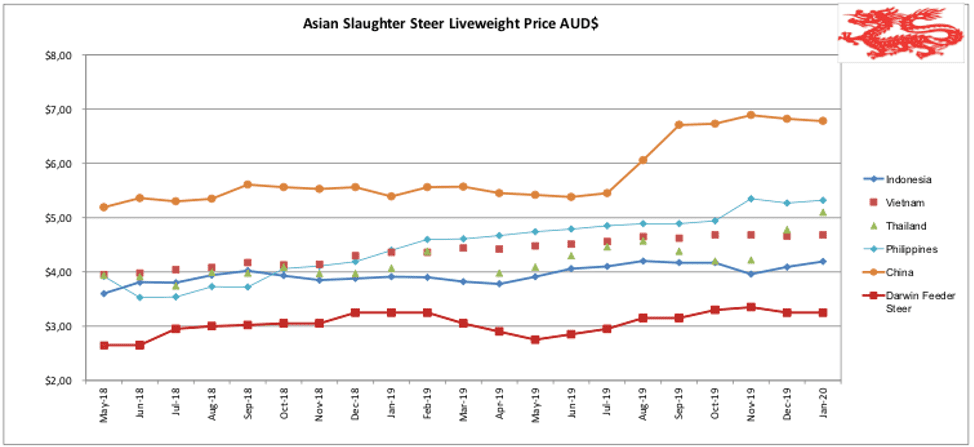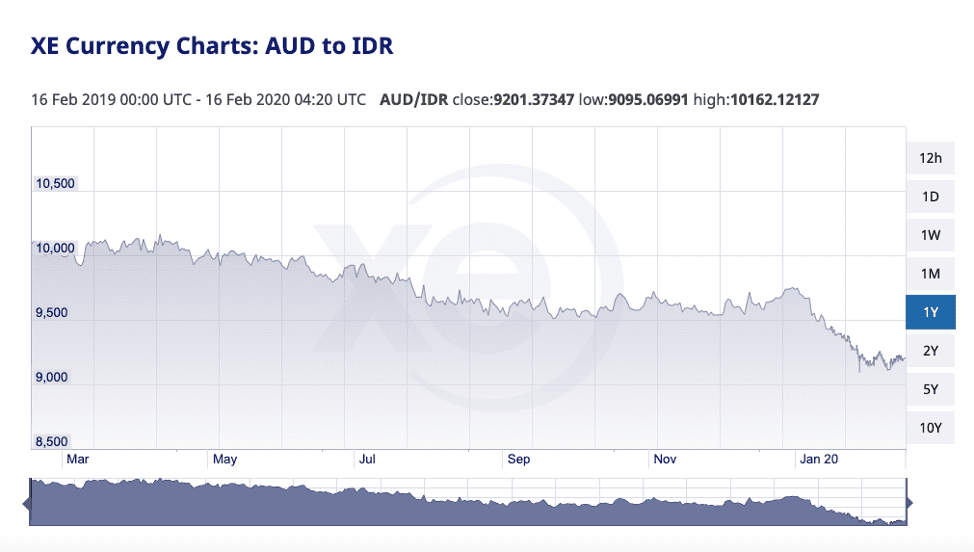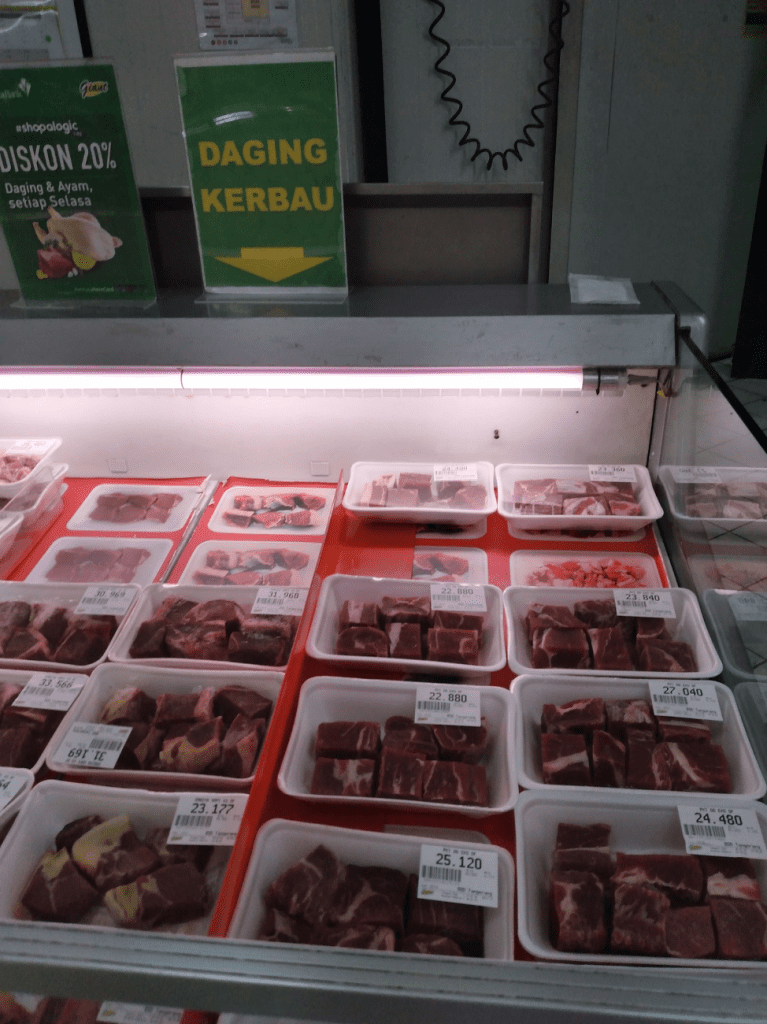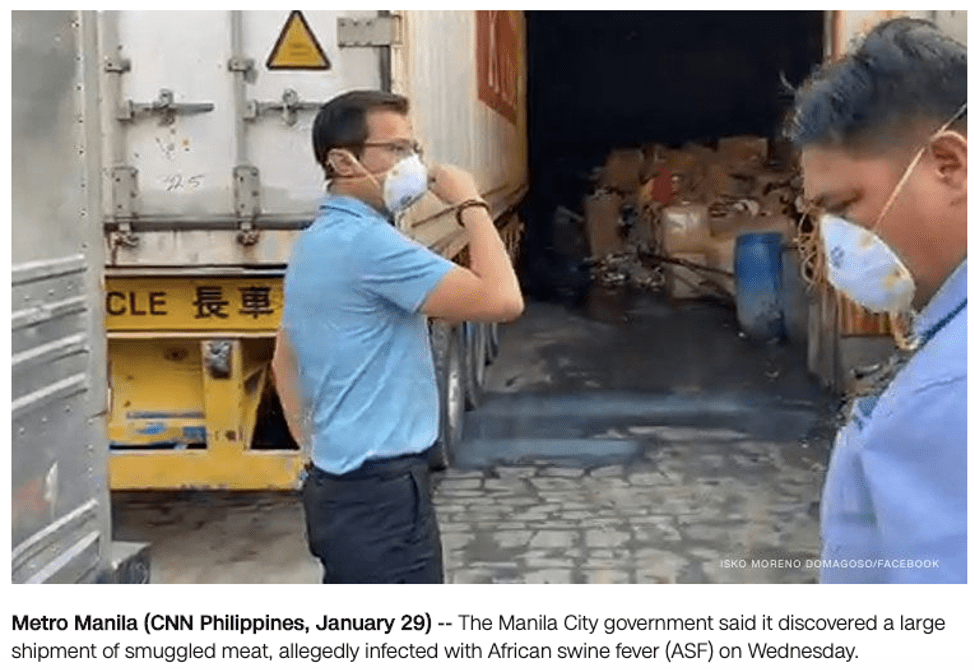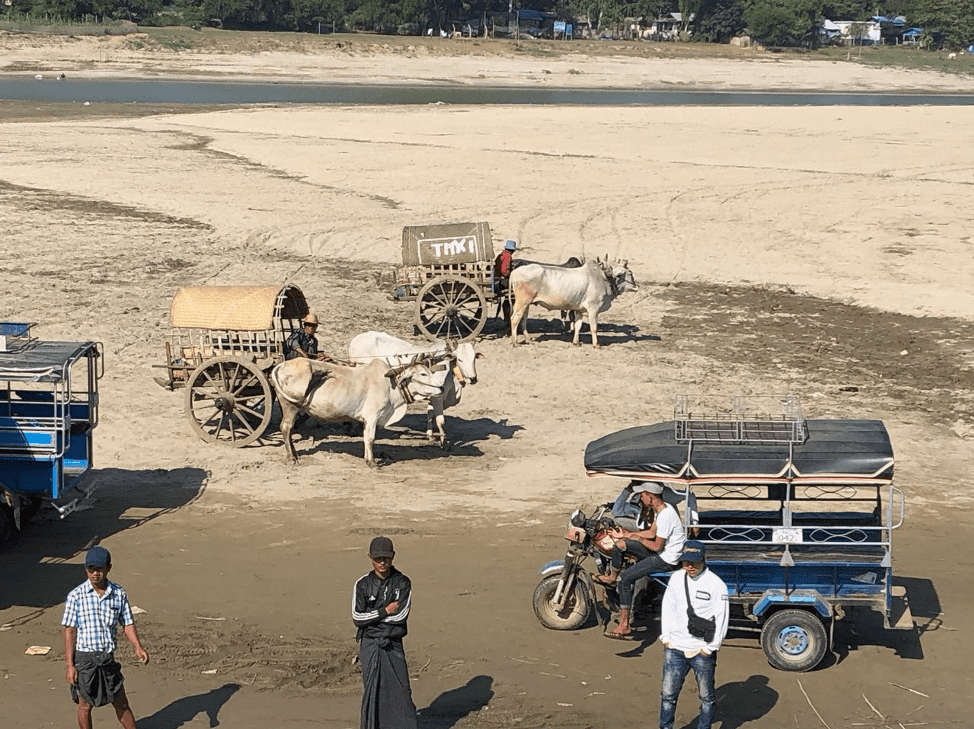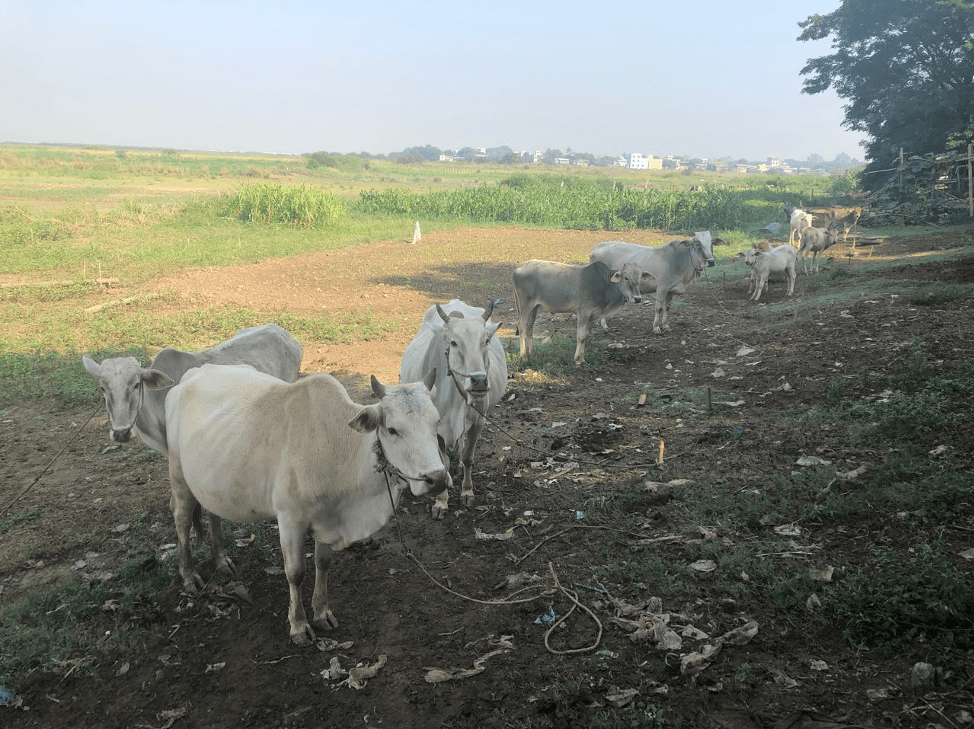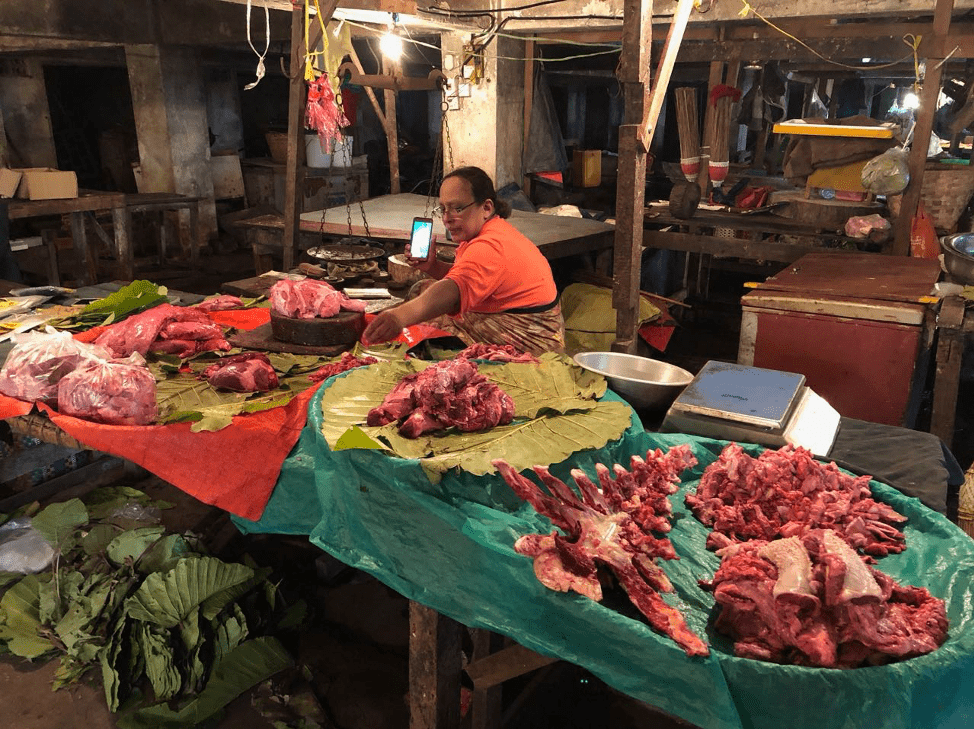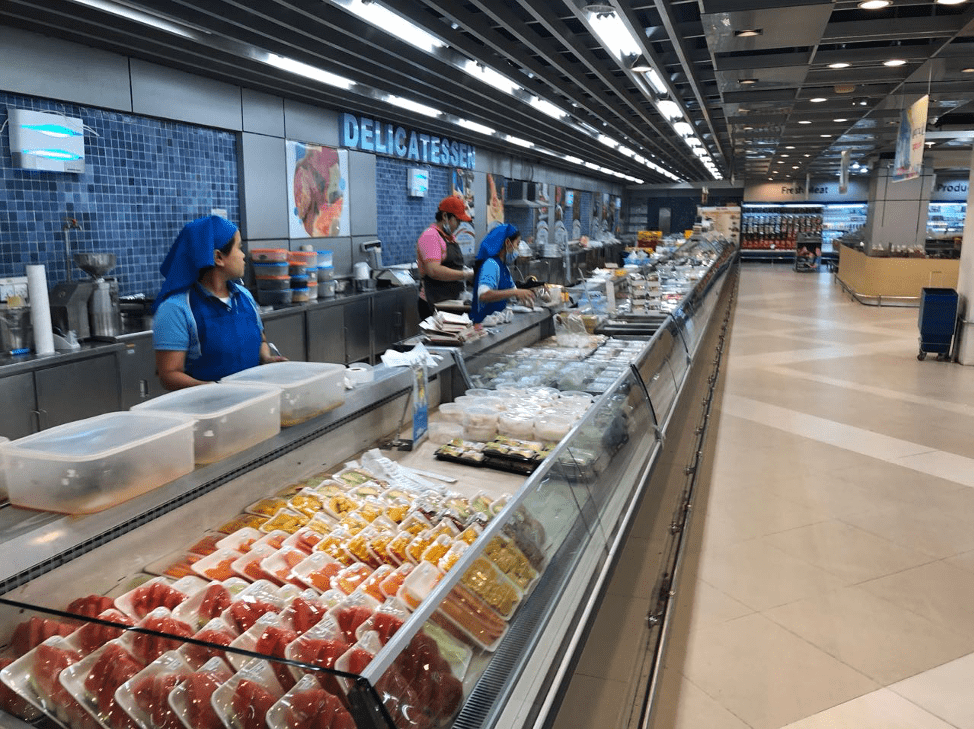
Indonesian version of this report
74rd Edition: January 2020
Key Points
- Indonesian cattle prices weaker but currency much stronger.
- Thai slaughter prices push through AUD$5 for the first time.
- African Swine Fever moves to infect Mindanao in southern Philippines
Indonesia: Slaughter Steers AUD $4.19/kg live weight (Rp9,300 = $1AUD)
Slaughter cattle prices continue to decline as a result of oversupply in a weak market with plenty of cheap alternatives including frozen Indian buffalo and Brazilian beef. Slaughter steers were reported as low as Rp38,500 per kg live weight in Lampung with fat cows down to Rp35,000 and lower. In Java prices were a little stronger so I am using Rp39,000 as this month’s indicator rate. The big mover during January has been the weakening of the AUD against all of our major live cattle customer countries with Indonesia showing the strongest moves. See chart below showing the fall of the AUD against the Rupiah of about 4% during January.
Export statistics show that Indonesia imported about 65,000 feeders in October, 59,000 in November falling to 45,000 in December. These figures suggest that oversupply is likely to continue for some months to come yet.
The first quarter is always a difficult time for importers as the northern wet season makes logistics difficult and always causes the cattle prices to rise at export ports. While the feeder steer prices have stayed steady at about $3.25 per kg live delivered Darwin during January as a result of the late wet season, recent rains across the north are likely to push this rate up sharply in February. While currency fluctuations are moving favourably for Indonesian importers I suspect that the jump in feeder prices will overwhelm the Rp gains made by the weakening of the AUD.
There have been a number of official announcements of massive increases in the volumes of imported frozen buffalo and beef but as yet no import permits have been issued for 2020. Ramadan 2020 begins on 23rd of April and ends of the 23rd of May so the government needs to get moving to ensure there will be plenty of product on hand in time for the festival period as it takes a long time to convert an import permit into a product on the wet market table. Qurban for 2020 is celebrated on the 30/31 July. To ensure plenty of fresh beef is available for Ramadan in May feeders need to be imported in February, likely to be the peak of pricing.
The Indonesia-Australia Comprehensive Economic Partnership Agreement has now been signed into law by both countries. While this is good news in terms of trade generally, the small reductions in tariffs on live cattle and beef are already swamped by the movements in both exchange rates and domestic prices in both markets. In short, in terms of the cattle and beef trade, the reality is that it is likely to have little impact in the domestic markets at either end.
Two unrelated viruses are likely to have a much greater impact on live cattle and beef markets even though they don’t infect cattle. Coronavirus is already exerting massive pressure on world trade flows associated with the Chinese lockdown of vast areas of the country. I live in Bali and it is already obvious that tourism numbers are drastically down as the largest single incoming group, the Chinese, have stopped arriving. It’s reported that they represent around 30 percent of all Bali tourists. The impact on accommodation and services they frequent is massive. The other virus of interest is African Swine Fever (ASF) with the disease continuing to crush the pig industry across Asia. ASF was confirmed in the north of Indonesia some months ago with recent conflicting reports of a possible outbreak in Bali over the last few weeks following reports of large numbers of pig deaths. A Balinese friend told me that his brother has a small pig farm to the east of Denpasar and all of his 40 pigs died last week. If I was a betting person I would wager that this is a very clear sign that ASF has arrived in Bali but we will have to wait for the FAO to make an official announcement on the basis of laboratory test results.
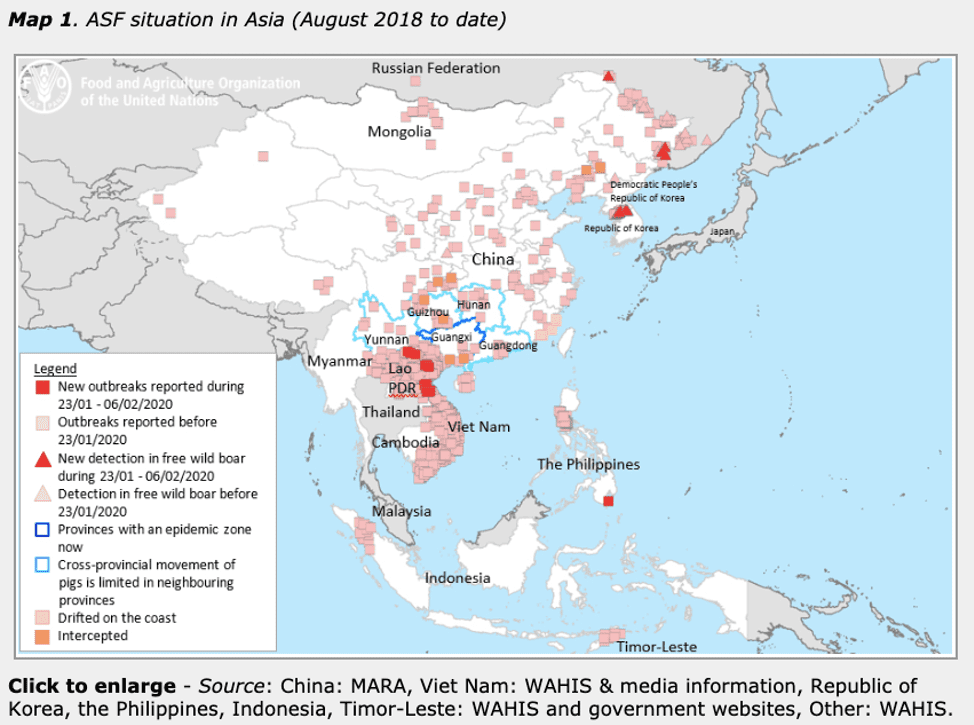
Map above showing the fortnightly ASF Asian situation update from the FAO. http://www.fao.org/ag/againfo/programmes/en/empres/ASF/situation_update.html
Darwin feeder steer prices remained relatively steady during January with the indicator rate holding at around $3.25 per kg landed Darwin. Widespread rains across the north during the first week of February have already forced this rate much higher.
Vietnam: Slaughter Steers AUD $4.68 / kg (VND15,900 to $1AUD)
Prices of slaughter cattle were steady across Vietnam while currency strengthened against the AUD to produce a stronger Aussie $ rate above. Domestic beef prices showed their expected rise and fall during the month in line with the national Tet holiday period on the 25th of January. Imported cattle numbers appear to be holding at around the 25,000 head per month mark although this might change once prices rise ex Townsville as a result of useful rains in many cattle producing areas of Queensland during January and early February. ASF continues to have a major impact on the pig industry with production remaining weak and prices remaining high.
China: Slaughter Cattle AUD $6.78 / kg (RMB 4.72 = AUD$)
Slaughter cattle prices are steady in Beijing and down a little in Shanghai but this seems almost irrelevant considering the massive impact of Corona virus on China and the global community during January and likely to continue at least through February and possibly a lot longer.
China is the largest consumer of meat in the world.
China has the largest number of international tourists per year at about 130 million.
Chinese students coming to Australia, Chinese tourists into Bali, Chinese buyers of live Western Australian lobsters, etc etc – all these and many more have come to a sudden halt so your guess is as good as mine as to what will be the international consequences.
I think it is safe to say that this will be an extremely disruptive event for global trade generally at the same time as crushing the domestic Chinese economy in vast areas across the country. No commodity or economic sector will be exempt from impact. All we can do is wait and hope that the disease is brought under control as quickly as possible.
The coronavirus epidemic, if it continues, may even be the black swan event that drives the world economy into recession.
Photo : Happy Holiday 🤧
Philippines: Slaughter Cattle AUD $5.32 / kg (Peso 34.8 to AUD$1)
No change in the domestic slaughter price just a strengthening of the Peso against the AUD as with all of our other customers.
The bad news for the Philippines is that ASF has broken out of Luzon and is now infecting a number of areas of the main southern island of Mindanao. See the FAO map above. This is a serious elevation of the ASF problem as Mindanao is a major pig producing area. There have also been recent reports of the discovery of a large pork smuggling racket bringing Chinese product into Luzon. It’s hard to believe anyone would be so irresponsible. Despite this, pork prices remained unaffected as of the end of January. Also the corona virus has been diagnosed in a person from Cebu in the central Philippines.
I understand there has been a little more inquiry from live cattle importers recently and this new ASF outbreak may contribute to pushing these cattle import plans forward at a faster rate.
Thailand: Slaughter Steers AUD $5.10 / kg (Baht 20.8 to $1AUD)
With the strengthening of the Thai Baht against the AUD combined with a 6% increase in the local prices, the Aussie rate for slaughter cattle in Thailand has burst through the AUD$5 barrier for the first time since this report commenced over 6 years ago. And the surprise from my agent is that rise in demand has come from Vietnam while the expected new demand from China has not occurred yet. Thailand has been a long time supplier of slaughter cattle to Vietnam but over the last 2 years or so had reduced the numbers exported there while Australia increased their exports making up the deficit. I am not sure of the reason for this sudden surge in Vietnamese demand apart from a combination of the Tet Lunar new year holiday on the 25th January and the ongoing shortage of pork as a result of the ASF epidemic.
Myanmar
I visited Myanmar during the middle of January with Angus Adnam and Mouse Sullivan. It is a stunningly beautiful and productive country where tourism is now encouraged and promoted by the national government. One the more recent initiatives is an on-line 30 day tourist visa which makes this formality much simpler and quicker than previously. We landed in Mandalay then sailed up the mighty Irrawaddy river for 6 days to Bhamo. We also visited the north eastern Shan State area near the Chinese border before travelling down to Inle lake and finally Yangon. I will write a more comprehensive article about our adventures at a later date. I can confidently recommend a visit to Myanmar for anyone looking for a new, safe and fascinating destination.
Myanmar is one of three countries in the world who do not use the metric system (the other two being Liberia and the United States). The unique Myanmar “viss” is a unit of measurement based on the weight of a single copper coin called a tical.
1 viss = 1.6 kg. The currency is the Kyat with AUD$1 having a value of about 1,000 Kyat. The price of beef in the wet market was 14,000 Kyat per viss. This converts to $14 per 1.6 kg or about AUD$8.75 per kg. Pork was selling for about K10,000 and fish for about K8,000 per viss.
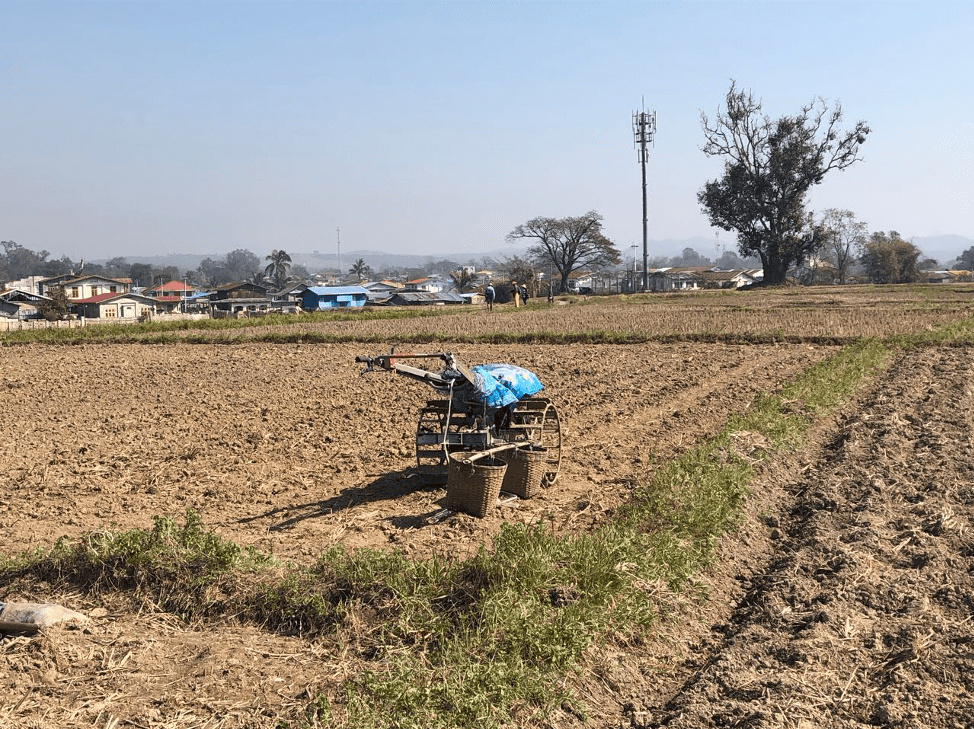
We did not see any ploughing using livestock. All agricultural work was carried out using these mechanical “Chinese buffalo”. The entire country is extremely well covered by 4G digital communications.
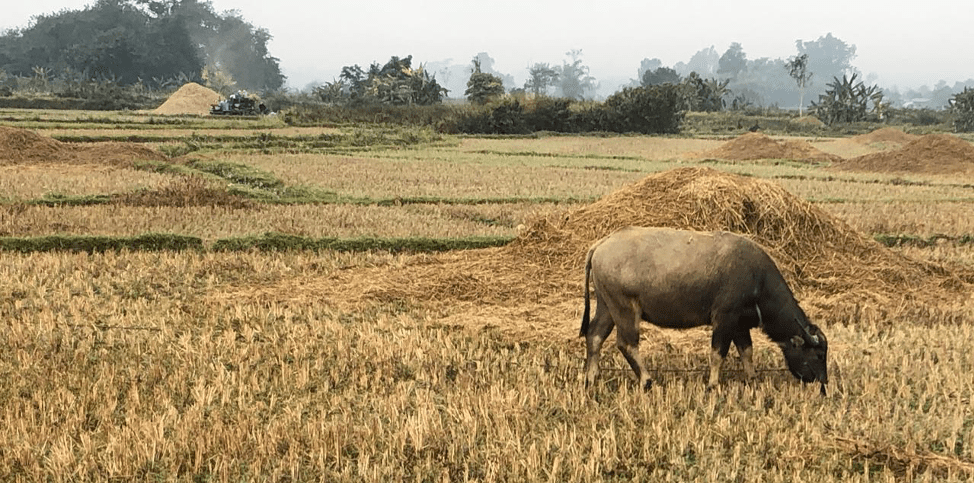
There are still many livestock in Myanmar but planting and harvesting – see in the background – are mostly done with machinery.
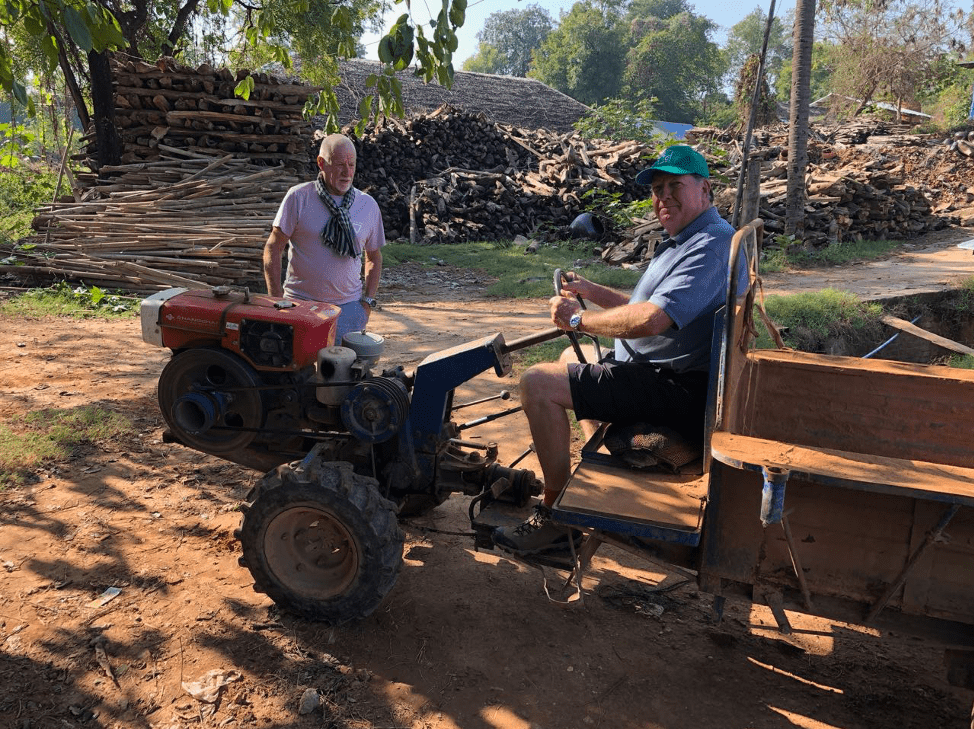
Angus and Mouse inspecting the standard means of agricultural transport, the very versatile “Chinese Buffalo” in this case with a freight trailer.
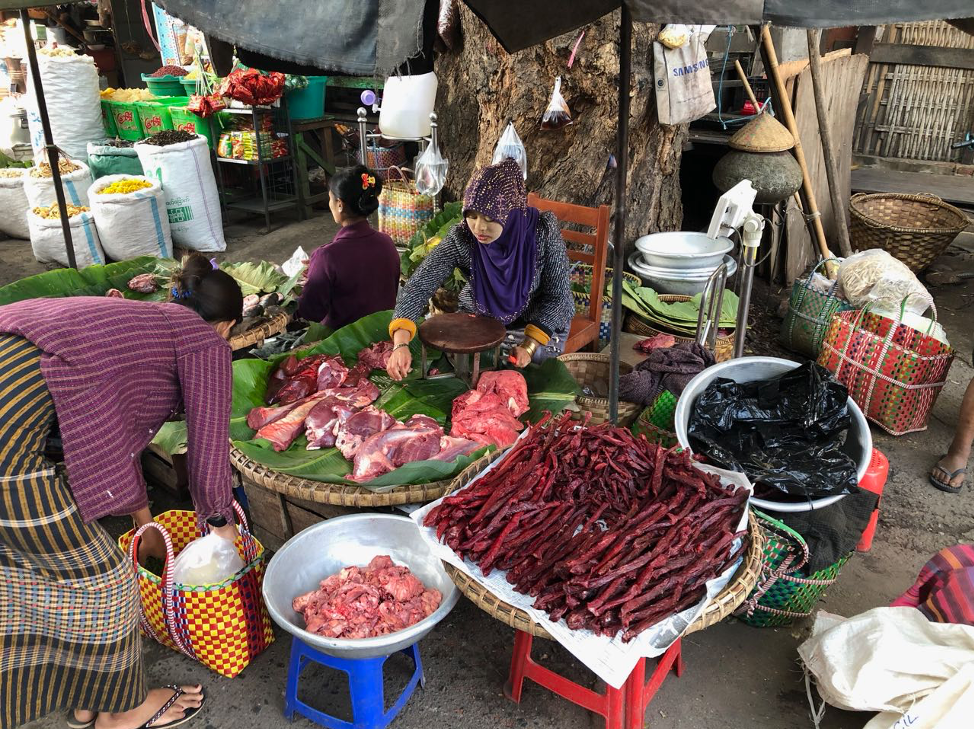
Beef retailing is conducted largely by Muslims as is the case in many other countries. The red sticks in the bottom right are salted beef or jerky.
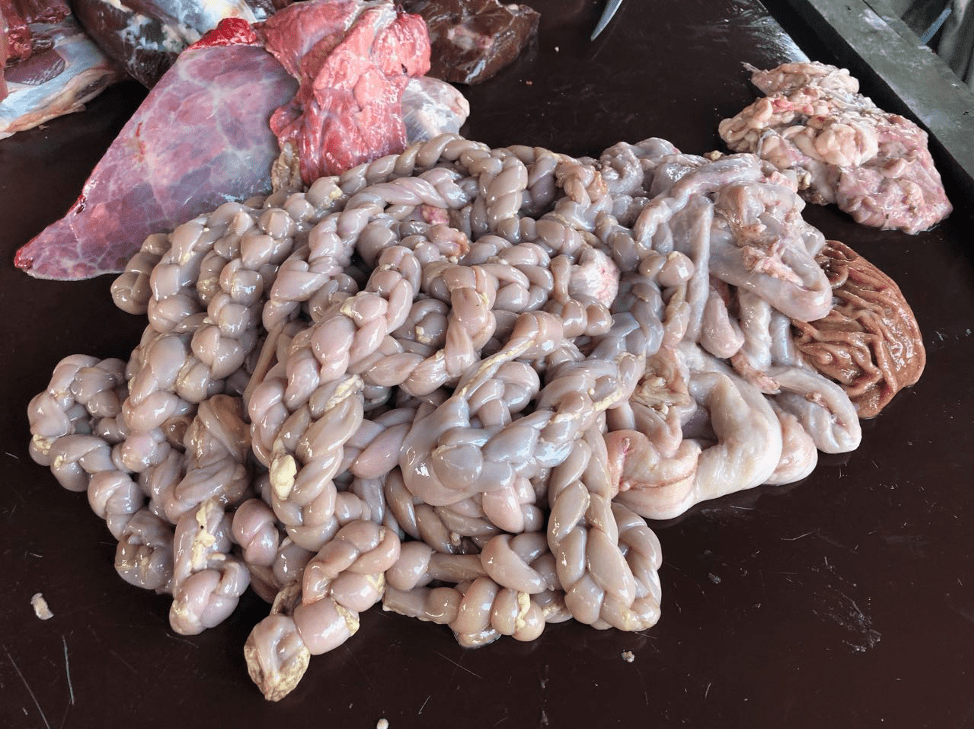
At the wet market at the Pyin Oo Lwin railway station, East of Mandalay in Shan state. This was a first for me – these beef intestines have been platted. When I asked the vendor why this was done, the reply was to make it more attractive. Silly question, it certainly got my attention. So did that lung at the back left.
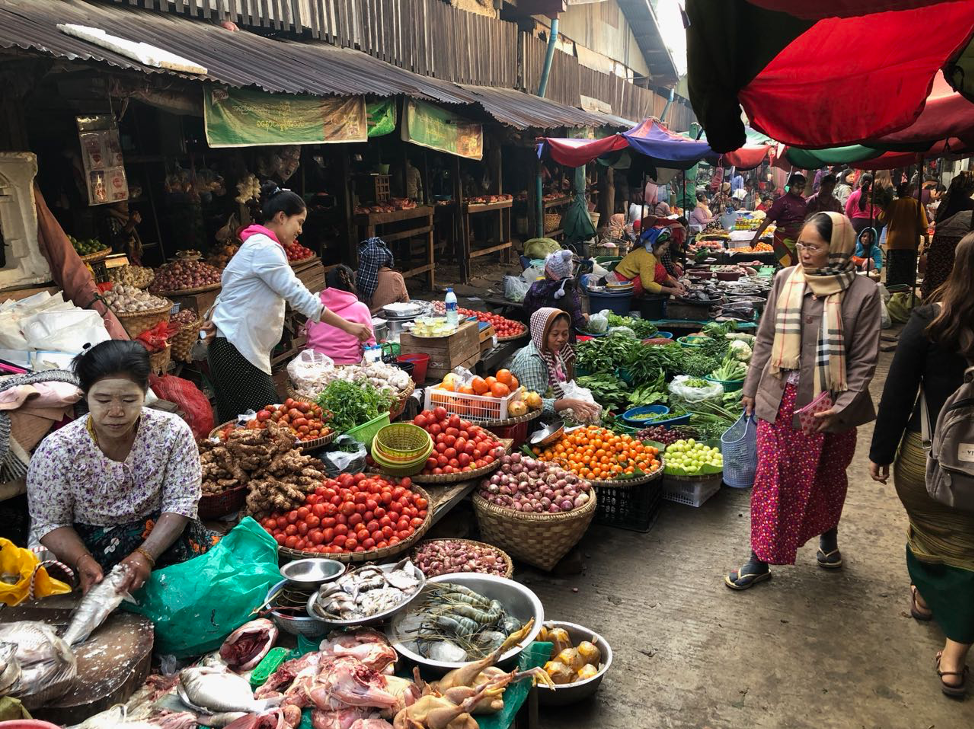
The largest wet market in Mandalay – far more interesting and popular than the very boring supermarket above.

The Irrawaddy river is too shallow to navigate at night so we would pull up on a sandbar at dusk each evening and enjoy a locally made Mandalay rum around the fire.
January 2020 prices
These figures are converted to AUD$ from their respective currencies which are changing every day so the actual prices here are corrupted slightly by constant foreign exchange fluctuations. The AUD$ figures presented below should be regarded as reliable trends rather than exact individual prices. Where possible the meat cut used for pricing in the wet and supermarket is Knuckle/Round.
| Location | Date | Wet Market
AUD$/kg |
Super market
$/kg |
Broiler chicken
$/kg |
Live Steer
Slaughter Wt AUD$/kg |
| Indonesia | August 19 | 13.47 | 16.37 | 3.42 | 4.20 |
| Rp9,600 | Sept 19 | 13.54 | 16.46 | 3.33 | 4.17 |
| Rp9,600 | Oct 19 | 13.54 | 16.64 | 3.96 | 4.17 |
| Rp9,600 | Nov 19 | 13.54 | 16.35 | 3.64 | 3.96 |
| Rp9,650 | Dec 19 | 13.47 | 13.47 | 3.63 | 4.09 |
| Rp9,300 | Jan 2020 | 13.98 | 19.14 | 3.76 | 4.19 |
| Philippines | August 19 | 12.71 | 12.71 | 4.10 | 4.89 |
| P35.4 | Sept 19 | 12.71 | 12.71 | 4.18 | 4.89 |
| P35.0 | Oct 19 | 12.86 | 13.14 | 4.43 | 4.94 |
| P34.6 | Nov 19 | 13.87 | 13.87 | 4.91 | 5.35 |
| P35.1 | Dec 19 | 13.68 | 13.68 | 4.84 | 5.27 |
| P34.8 | Jan 2020 | 13.79 | 13.79 | 4.45 | 5.32 |
| Thailand | August 19 | 10.57 | NA | 3.37 | 4.57 |
| THB20.8 | Sept 19 | 10.58 | NA | 3.37 | 4.38 |
| THB20.7 | Oct 19 | 10.63 | NA | 3.38 | 4.20 |
| THB20.6 | Nov 19 | 10.68 | NA | 3.40 | 4.22 |
| THB20.9 | Dec 19 | 11.00 | NA | 3.35 | 4.78 |
| THB20.8 | Jan 2020 | 11.06 | NA | 3.37 | 5.10 |
| Vietnam | August 19 | 19.75 | NA | NA | 4.65 |
| D15,800 | Sept 19 | 19.62 | 18.10 | 5.06 | 4.62 |
| D15,800 | Oct 19 | 19.62 | 18.10 | 5.06 | 4.68 |
| D15,800 | Nov 19 | 19.62 | 18.10 | 4.43 | 4.68 |
| D16,000 | Dec 19 | 19.37 | 17.88 | 4.99 | 4.66 |
| D15,900 | Jan 2020 | 19.50 | 17.99 | 5.03 | 4.68 |
| China Beijing | August 19 | 14.17 | 18.75 | 4.38 | 5.88 |
| Y4.84 | Sept 19 | 14.88 | 19.00 | 4.88 | 6.71 |
| Y4.83 | Oct 19 | 16.15 | NA | 4.89 | 6.83 |
| Y4.79 | Nov 19 | 17.12 | 19.21 | 4.13 | 6.68 |
| Y4.84 | Dec 19 | 16.12 | 19.01 | 3.72 | 6.61 |
| Y4.72 | Jan 2020 | 17.80 | 15.17 | 4.45 | 6.78 |
| Shanghai | August 19 | 19.58 | 22.50 | 4.25 | 6.25 |
| Sept 19 | 19.00 | 23.97 | 3.97 | 6.71 | |
| Pork per kg | Oct 19 | 18.63 | 24.01 | 4.03 | 6.6 3 |
| Beijing Y46.6 | Nov 19 | 20.04 | 24.22 | 4.07 | 7.09 |
| Shanghai 40.2 | Dec 19 | 19.83 | 25.20 | 3.88 | 7.02 |
| Jan 2020 | 20.3 | 25.00 | 4.24 | 6.78 | |
| Darwin Feeder Steer | June 19
$2.90 |
July 19
$3.00 |
August 19
$3.15 |
Sept 19
43.15 |
October 19
$3.30 |
| Nov 19
$3.35 |
Dec 19
$3.25 |
January 2020
$3.25 |
Feb 2020 | March 2020 |

